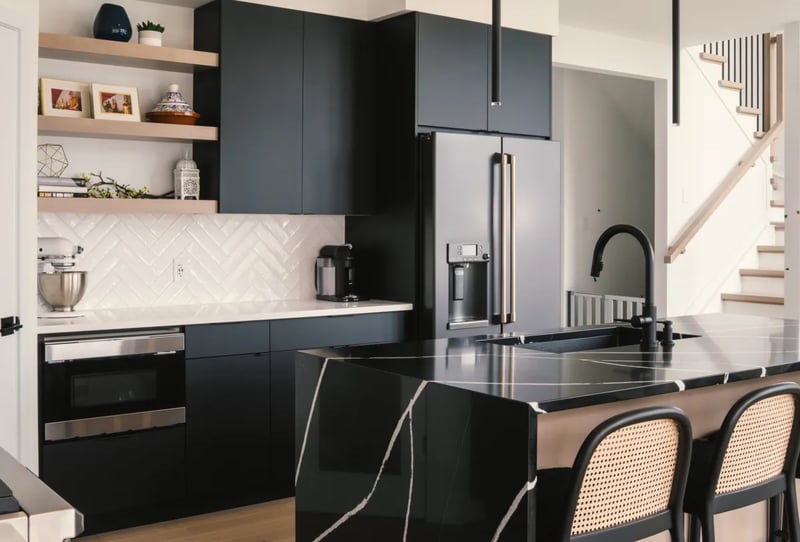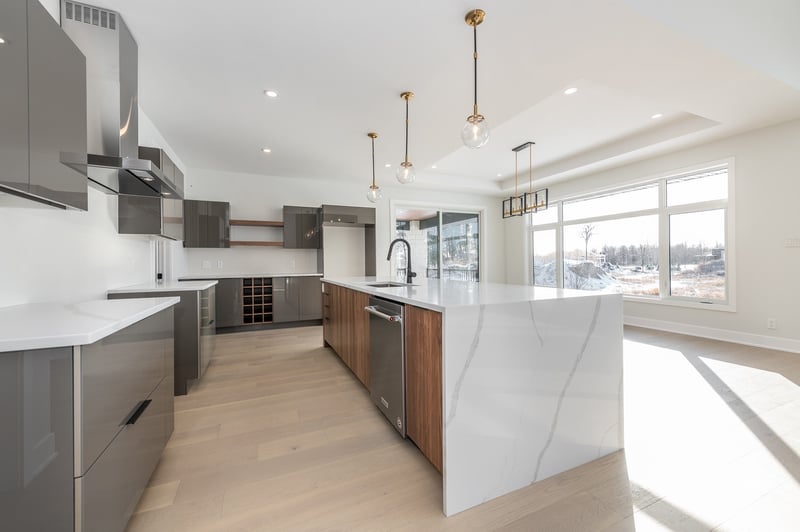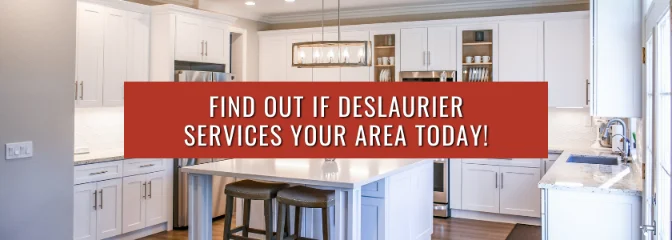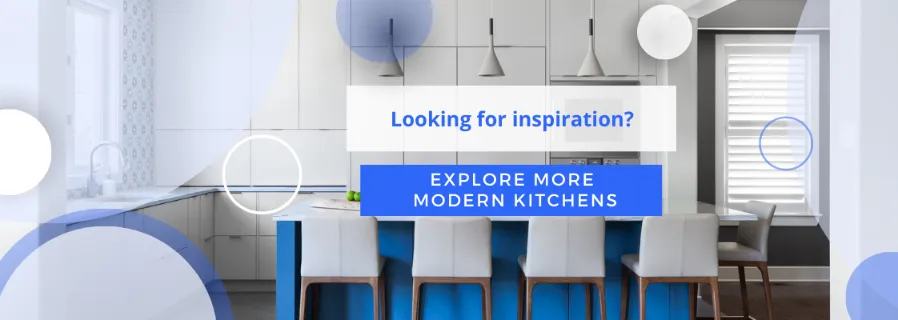21/04/2023 • Waterfall Island, Blog, Design Tips
Waterfall Countertop Ends: Are They Right for Your Kitchen Island?
Estimated Read Time: 5 Minutes
Waterfall kitchen islands have emerged as a popular design trend in modern kitchens, thanks to their unique style and functionality.
Not only do they add an eye-catching statement piece to your kitchen, but they also offer practical benefits like extra countertop space and seating options.
At Deslaurier, we have over 40 years of experience specializing in custom cabinets and kitchen design. We’ve seen the rise in the popularity of kitchen islands and the exciting design trends that come with them. The evolution of waterfall islands is one of them.
In this article, we will explore everything you need to know about waterfall kitchen islands, including their design, fabrication, and the costs involved.
Let’s get started!
|
Table of Contents |
What are Waterfall Islands?
Waterfall kitchen islands really came to prominence in the early-2010s, gaining incredible popularity in high-end, modern kitchen designs.
If you're not familiar with waterfall kitchen islands, they are essentially when the countertop material of the kitchen island extends down one or both sides to create a seamless, flowing effect.
This design feature is aptly named because it resembles the look of water flowing over a precipice, or "waterfalling" down the sides of the island. The result is a sleek and modern design that can add a touch of sophistication and elegance to any kitchen.

A slab of the same countertop material is placed on the end panel of the island and meets flush at a 90-degree angle with the horizontal surface.
Waterfall countertops are delightfully dramatic and one of the best ways to instantly turn your kitchen island into an aesthetic focal point.
These seamless waterfall sides negate the need for a standard countertop overhang. In fact, other than above your cabinet drawers and doors, the only reason for countertop overhangs with waterfall islands is to incorporate luxurious kitchen island seating.
How are Waterfall Ends Made?
The goal of a waterfall island is to have all sides appear to be made out of one continuous countertop material. That comes down to its fabrication method.
Manufacturers will cut the slab precisely with a computer numerical control laser cutter (CNC). This produces mitered edges (each piece cut at a 45-degrees) that fit together seamlessly to create a perfect 90-degree angle.
Butcher block waterfall ends can also be crafted using butt joints (two flat ends abutting against one another) as opposed to mitered joints.
This presents the opportunity to play around with wood grain. You can utilize a checkerboard countertop surface with a longer, end-grain aesthetic for the sides.
Choosing the Right Material
Like most features in your kitchen, the material you select plays a large role in your island’s waterfall countertop.
The unique profile of a waterfall countertop edge means you need to choose a surface material carefully. The allure of natural stones like granite and marble always springs to mind.
Many homeowners choose a waterfall style precisely because they want the countertop to look like it’s made from one continuous material. This is difficult to do with a countertop made from wood, marble, granite, or any other natural material that contains unique characteristics like veining and patterning.

Of course, not everyone wants the appearance of a perfectly matched waterfall island. Some homeowners even use different materials on the sides than they do on the countertop surface, creating a two-tone waterfall island!
However, if you’re after that continuous cascading waterfall effect, mismatched veining can’t provide that.
Because of this, most designers now use quartz countertops to create a consistent waterfall aesthetic. Fabricators can flawlessly match veining or exclude it altogether to create a waterfall countertop island that looks like one cohesive material.
Maintenance is another key factor.
Stones like marble and granite are porous – meaning they might absorb liquid or oil spills – and require regular resealing. Butcher block also comes with concerns regarding its overall durability and vulnerability to swelling.
Of course, marble, granite, and butcher blocks are great! They wouldn’t be so popular if they weren’t. That being said, when dealing with so much additional material than a standard island countertop, selecting a low-maintenance product is beneficial and recommended by our team.
That’s where the benefits of quartz countertops make for a much more practical solution for day-to-day life. While waterfall granite or marble countertops are porous and expensive to maintain, quartz is entirely non-porous and requires no routine maintenance.
Ultimately, we recommend that the material you choose for your waterfall island should depend on your personal style, budget, and, perhaps most importantly, your maintenance preferences.
Cost
For the most part, determining the cost of a waterfall island is the same as picking out a regular kitchen countertop. The price of the surface you select will depend on the material you choose.
Check out our article for an in-depth breakdown of the cost of popular countertop materials.
Of course, waterfall ends will require a lot more material. The price will naturally increase with the more material you need – which can be a lot depending on the size of your island – but nothing else should change from a product pricing standpoint.
Where the expenses can really increase is the fabrication process to create waterfall ends.
As we mentioned earlier, a CNC laser is required to create the mitered waterfall joints. It’s a labour-intensive process that can increase the cost of your countertops by several thousand dollars.
Further, installation is also much different than a standard countertop. It’s a more delicate process and will take a bit longer than most surfaces.
All in all, with the additional materials, fabrication, and installation, don’t be surprised if your waterfall island costs more than double what it would for a standard countertop surface.
Where to Put Electrical Outlets
Most homeowners designing a kitchen island are so preoccupied with their cabinet selection or finding the perfect countertop stone that they overlook a small but crucial issue: electrical outlets.
In fact, it’s one of our primary kitchen island design mistakes to avoid!
The electrical building code requires a kitchen island to include at least one power outlet for every 24” of an island. So, if you have a 4-foot (48”) kitchen island, you’ll need to equip it with two electrical outlets.
The go-to location for most homeowners is to install them on the side panels of the island. That way they’re easy to access and don’t interfere with the island cabinetry.
But what if you have plans for your island countertop to continue into luscious waterfall ends, or you simply don’t want an outlet built into side panels?
You can also install an outlet in a front facade or column. These pieces of millwork sit along the end of the kitchen island cabinetry and are a great place to implement electrical outlets without compromising the integrity of a functional cabinet.
This method is best utilized with 4 inches of width, otherwise, you’re cutting into cabinet materials or running the risk of causing structural alterations.
When done correctly, it’s the perfect location for electrical outlets to remain free and clear from interfering with your beautiful waterfall island ends.
They're Not Just For Islands
While the kitchen islands are by far the most popular location for waterfall ends, they’re not the only place they can be utilized!
For example, a waterfall end could be used to create a sleek and modern bar area or as a unique feature on a built-in shelving unit. They’re a great accent piece that adds immediate flair to the interior of your home.
You can even include a waterfall at the end of a long row of kitchen cabinets where a finished cabinet side or applied panel would typically be used. Instead, a waterfall end can add a unique touch of elegance that sets your kitchen apart from the rest!
Design with Deslaurier Custom Cabinets
By now, you can probably see why these one-of-a-kind islands have become so popular. They add eye-catching beauty to your home that’s hard to replicate. However, they are quite expensive, and we suggest always taking into account your budget, style, and lifestyle needs.
If you’re in the market for custom cabinets and kitchen design, Deslaurier Custom Cabinets has everything you need! With over 40 years of experience in our name, we provide our clients with a fully customized design process with our talented team of designers.
Book a consultation today with a Deslaurier design expert at our Jupiter, Florida Showroom or schedule a virtual meeting!
Live outside the area? Find a Dealer to connect with near you! Interested in becoming an authorized Deslaurier dealer? Visit our Become a Dealer page to learn more!

